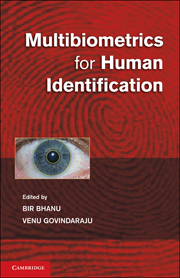Book contents
- Frontmatter
- Contents
- List of Contributors
- Preface
- Introduction
- PART I MULTIMODAL AND MULTISENSOR BIOMETRIC SYSTEMS
- PART II FUSION METHODS IN MULTIBIOMETRIC SYSTEMS
- 5 Biometric Authentication: A Copula-Based Approach
- 6 An Investigation into Feature-Level Fusion of Face and Fingerprint Biometrics
- 7 Adaptive Multibiometric Systems
- PART III HYBRID BIOMETRIC SYSTEMS
- PART IV DATABASES AND SECURITY
- PART V PERFORMANCE OF MULTIBIOMETRIC SYSTEMS
- Plate section
5 - Biometric Authentication: A Copula-Based Approach
from PART II - FUSION METHODS IN MULTIBIOMETRIC SYSTEMS
Published online by Cambridge University Press: 25 October 2011
- Frontmatter
- Contents
- List of Contributors
- Preface
- Introduction
- PART I MULTIMODAL AND MULTISENSOR BIOMETRIC SYSTEMS
- PART II FUSION METHODS IN MULTIBIOMETRIC SYSTEMS
- 5 Biometric Authentication: A Copula-Based Approach
- 6 An Investigation into Feature-Level Fusion of Face and Fingerprint Biometrics
- 7 Adaptive Multibiometric Systems
- PART III HYBRID BIOMETRIC SYSTEMS
- PART IV DATABASES AND SECURITY
- PART V PERFORMANCE OF MULTIBIOMETRIC SYSTEMS
- Plate section
Summary
Introduction
The process of authentication involves verifying the identity of a person claiming access to one or more resources of a system. Authentication systems can be based on passwords, security tokens, biometrics, or combinations of them (O'Gorman 2003). Passwords are words, phrases, or alphanumeric personal identification numbers (PINs) that serve as short-form indicators of a person's identity. They are usually created by authorized users during the enrollment or registration phase (e.g., creating computer user accounts) and are kept secret from others. Security tokens, on the other hand, are physical devices that the users are required to carry to be allowed access to the system. More recent designs of automatic human recognition systems involve the use of features such as face, fingerprints, iris, or behavioral traits such as gait or rate of keystrokes. For example, in building access control applications, a person's face may be matched to templates stored in a database consisting of all enrolled users. Decision to allow or deny entry is then taken based on the similarity score generated by the face-matching algorithm. Such security systems that rely on biometrics have several advantages over the more conventional ones (passwords or security tokens). For example, a PIN, if leaked, may be used by an unauthorized person causing serious security concerns. However, a person's physical signature belongs only to that individual and is extremely difficult if not impossible to emulate. Further, biometric systems may be more convenient and user friendly because there is no password to remember or any token to carry.
- Type
- Chapter
- Information
- Multibiometrics for Human Identification , pp. 95 - 119Publisher: Cambridge University PressPrint publication year: 2011
- 5
- Cited by

